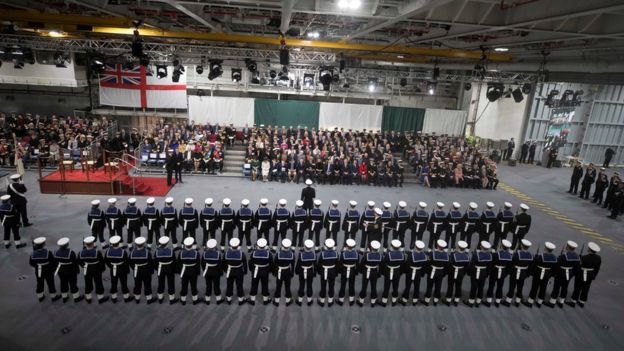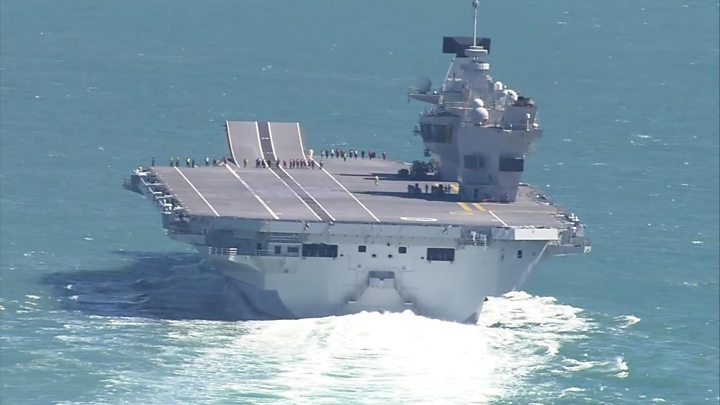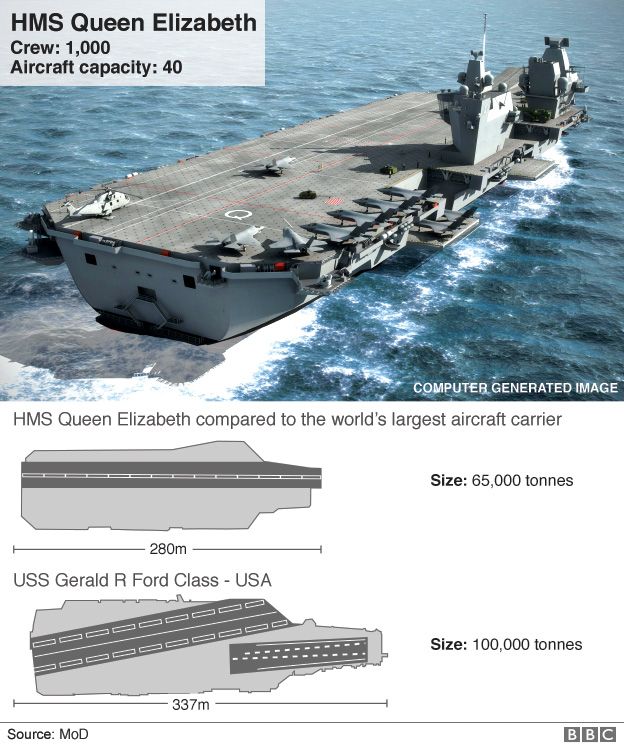Why are the Queen Elizabeth class carriers so big?
By George Allison
July 21, 2017
The Queen Elizabeth Class aircraft carriers are the largest surface warships ever constructed for the Royal Navy and represent a significant increase in capability.
The vessels will be utilised by all three branches of the UK Armed Forces and will provide eight acres of sovereign territory. Both ships will be versatile enough to be used for operations ranging from high intensity conflict to providing humanitarian aid and disaster relief. The class have increased survivability as a result of the separation and distribution of power generation machinery throughout each ship.
The class has been designed with twin islands which separates the running of the ship from the flying operations resulting in greater visibility of flying operations. Surprisingly for their sheer scale, each ship will only have a total crew of 679, only increasing to the full complement of 1,600 when the air elements are embarked. Why are they so big? Wouldn’t several smaller carriers be more cost effective?
HMS Queen Elizabeth, HMS Sutherland and HMS Iron Duke.
“The reason that we have arrived at what we have arrived at is because to do the initial strike package, that deep strike package, we have done really quite detailed calculations and we have come out with the figure of 36 joint strike fighters, and that is what has driven the size of it, and that is to be able to deliver the weight of effort that you need for these operations that we are planning in the future. That is the thing that has made us arrive at that size of deck and that size of ship, to enable that to happen.
I have talked with the Chief of Naval Operations in America. He is very keen for us to get these because he sees us slotting in with his carrier groups. For example, in Afghanistan last year they had to call on the French to bail them out with their carrier. He really wants us to have these, but he wants us to have same sort of clout as one of their carriers, which is this figure at 36. He would find that very useful, and really we would mix and match with that.”
— Admiral Sir Alan West, evidence to the Select Committee on Defence, 24 November 2004
What does a large carrier offer that a smaller one doesn’t? Operational experience shows that larger carriers have significant advantages. For example, the Invincible class typically hosted around 12 Sea Harriers and with that their decks were fairly crowded. Tabloids often like to quote 12 as the maximum number of F-35B’s the new Queen Elizabeth class will be able to carry, however this is nonsense.
The term now used for the carriers embarked squadrons is ‘Carrier Air Wing’ (CVW). ‘Tailored Air Group’ (TAG) has been used in the past for tailored rotary air groups and we understand the term has fallen out of use.
The carriers, in peacetime, will usually deploy with around 12-24 F-35B’s and a number of various helicopters. The vessels are capable of deploying a variety of aircraft in large numbers, up to a maximum in the upper fifties in surge conditions.
In addition to the joint force of Royal Air Force and Royal Navy F-35Bs and their pilots, the air wing is expected to be composed of a ‘Maritime Force Protection’ package of nine anti-submarine Merlin HM2 and four or five Merlin for airborne early warning; alternatively a ‘Littoral Manoeuvre’ package could include a mix of RAF Chinooks, Army Apaches, Merlin HC4 and Wildcat HM2.
The Crowsnest AEW&C aircraft will come from the embarked Mk2 Merlins.
We understand that the composition of the CVW is a balance between ship capacity and squadron availability.
The two Queen Elizabeth class carriers can accommodate around twice as many aircraft as the three Invincible class.
This metric isn’t the primary advantage of a larger ship class as each F-35B is considerably larger than a Harrier and has much better performance. There’s very little reason not to build larger carriers, it was once estimated that steel accounted for only about 20 percent of the cost of the ship.
The smaller the carrier, the fewer aircraft it can support and the greater waste of resources it becomes when compared to larger carriers. The smaller the carrier, the more the vessels size restricts the performance of the aircraft onboard. The three Invincible class carriers, which the Queen Elizabeth class will replace, operated small and relatively low performance Sea Harriers. The larger F-35 that will operate from the new carriers is more effective than the Sea Harrier. It carries much more and it flies much faster and much farther. It’s also a more complicated aircraft, requiring more equipment and personnel.
A carrier accommodating as many F-35Bs as the Invincible accommodated Sea Harriers would be far larger by necessity in order to effectively operate the modern, larger aircraft.
The ships former commanding officer, Captain Simon Petitt, rightfully pointed out that there is a lot of symbolism in modern warfare and that having a ship the size of HMS Queen Elizabeth, which will be the navy’s biggest ever, was significant. The sight of a heavily equipped 70,000 tonne carrier, which is almost 300 metres long, heading towards a potential enemy had a deterrent effect that is essential if the UK wants to project influence across the world Petitt claims.
“It is massively visible, you can range back in history and see the value of this. Everything from Nelson deterring Admiral Villeneuve from leaving Cadiz all the way to the big battleships of early 20th century, to what we are doing now.
The Americans use it all the time. We currently haven’t got this level of carrier capability. The bigger the capability the more influence you have to bear.”
So great is the impact of larger vessels as a deterrent, they’re often used as a geopolitical chess piece. American governments have, since the second world war, moved aircraft carriers around to demonstrate American resolve.
The particular benefits of using carriers in this way are that they operate on the high seas, where permission is not needed from other countries. Indeed, since modern US carriers are large and imposing they “show the flag” to great effect due to their sheer size alone. Equally, it is often argued that had the Royal Navy had two full sized carriers in 1982 it is more than possible that Argentina would not have attempted to take the Falklands in the first place.
Larger carriers don’t have to be packed to bursting point with aircraft to achieve their greatest effectiveness, even with fewer aircraft on board, a ship with a large flight deck can rearm and refuel aircraft much more quickly, this is typically why they allow for much higher sortie generation rates than smaller vessels.
The more crowded the flight deck, the slower the turn-around of each aircraft, the lower the sortie generation rate.
Size also offers greater storage capacity, larger vessels do not have to be resupplied as often, impacting both the effectiveness of the carrier and her vulnerability. Because a carrier is more vulnerable when being replenished, the vessel typically withdraws from station for that function. Much of the time lost is the time spent heading away from station and returning. The smaller the carrier, the more time lost and a bigger logistics chain required in support.
HMS Queen Elizabeth seen from frigate HMS Iron Duke
A larger ship is likely to survive damage that will sink or disable a smaller one. The smaller the proportion of a ship that gets damaged, the better the chance that the ship can survive the damage and keep on fighting. It takes sheer size to provide enough protection against all the weapons likely to be used against a carrier, from bombs to cruise missiles to torpedoes.
Thislesson comes from the second world war, where lessons learned from operations with the large converted battlecruisers in comparison with the smaller purpose-built aircraft carriers had taught both the Royal and US Navies that large carriers were more survivable than smaller ones due primarily to the large number of watertight compartments.
If a complement of aircraft that would typically be found on one large carrier is split among several smaller carriers, then each vessel needs its own escorts unless they operate together. This would require more resources to operate effectively. It might be argued that splitting up a carrier force would make it more difficult for an enemy to deal with all of it at once but the price paid in escorting ships would be high, making it unfeasible for most navies. Indeed, the most significant effect this would have would be requiring more smaller carriers to do the job of one large vessel, further increasing costs. Each of the smaller carriers in the group is less survivable, more wasteful and less effective than a single larger ship.
The Queen Elizabeth class mark a change from expressing carrier power in terms of number of aircraft carried, to the number of sortie’s that can be generated from the deck. The class are not the largest class of carrier in the world but they are most likely the smallest and least expensive carrier the Royal Navy could build which still have the advantages that large carriers offer.
https://ukdefencejournal.org.uk/why-are-the-queen-elizabeth-class-carriers-so-big/






